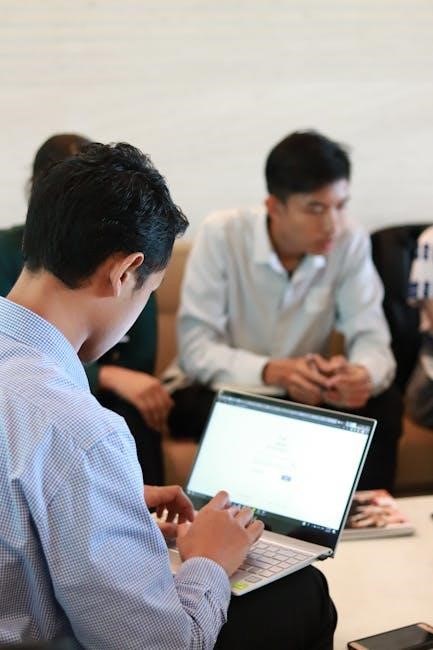Multitasking, often misunderstood as a productivity booster, is revealed as a myth in “The Myth of Multitasking” PDF, showing how it hinders focus and efficiency due to brain limitations.
Defining Multitasking and Its Common Misconceptions
Multitasking is often defined as the ability to perform multiple tasks simultaneously, but research reveals it is an illusion. The brain cannot process several tasks at once; instead, it rapidly switches between them, a concept known as task-switching. Many believe multitasking boosts productivity, but studies show it leads to decreased efficiency, increased errors, and mental fatigue. The misconception arises from the false sense of accomplishment when juggling tasks, though true productivity lies in focused, single-tasking efforts. This myth is central to the discussion in “The Myth of Multitasking” PDF, which explores how multitasking affects performance and cognition.
Why Multitasking is Often Perceived as a Productivity Tool
Multitasking is widely seen as a productivity tool due to societal pressure to accomplish more in less time. The fast-paced modern world glorifies juggling tasks, making it seem efficient. However, as “The Myth of Multitasking” PDF explains, this perception stems from a misunderstanding of how the brain operates; People confuse task-switching with true multitasking, believing they’re getting more done when they’re actually dividing their attention. This illusion of productivity is reinforced by the instant gratification of completing small tasks, even though overall efficiency and quality often suffer as a result.

The Neuroscience Behind Multitasking
Neuroscience reveals the brain’s inability to handle multiple tasks simultaneously, relying instead on rapid task-switching, which reduces productivity and increases mental fatigue.
How the Brain Processes Multiple Tasks
The brain does not truly multitask; instead, it rapidly switches between tasks, a process called task-switching. Each switch requires the prefrontal cortex to disengage from one task and reorient to another, creating inefficiencies. This constant shifting reduces productivity and increases mental fatigue. Research from “The Myth of Multitasking” PDF reveals that such constant task-switching overloads the brain, leading to errors and decreased accuracy. Contrary to the belief that multitasking enhances productivity, it actually fragments attention and diminishes cognitive performance, highlighting the brain’s limitations in handling multiple tasks simultaneously.
The Role of Task-Switching in Multitasking
Task-switching is the core mechanism behind multitasking, where the brain rapidly shifts focus between tasks. However, this process is inefficient, as the prefrontal cortex must disengage from one task and reorient to another. Each switch consumes mental resources, leading to time loss and increased mental fatigue. Research from “The Myth of Multitasking” PDF highlights that frequent task-switching reduces productivity and accuracy, as the brain struggles to maintain focus on multiple tasks. This constant shifting undermines performance, revealing that true multitasking is an illusion and that task-switching is inherently costly to cognitive efficiency.

The Impact of Multitasking on Productivity
Research from “The Myth of Multitasking” PDF reveals that multitasking significantly reduces productivity, as constant task-switching leads to time loss and decreased accuracy in task completion.
Research Findings on Multitasking and Efficiency
Research from “The Myth of Multitasking” PDF reveals that multitasking often decreases productivity by up to 28% due to mental switching costs. Studies show that the brain cannot process multiple tasks simultaneously but instead switches between them, leading to inefficiency. Contrary to popular belief, multitasking does not save time; it often results in a 40% increase in time spent on tasks. These findings challenge the notion that multitasking enhances efficiency, highlighting its counterproductive nature and the importance of focusing on single tasks for better outcomes.
How Multitasking Affects Performance and Accuracy
Multitasking significantly degrades performance and accuracy by overloading the brain, which cannot process multiple tasks simultaneously. Instead, it rapidly switches focus, leading to a 40% reduction in productivity. Research indicates that multitasking increases error rates by up to 50%, as divided attention impairs cognitive functions like memory and problem-solving. This “task-switching penalty” erodes efficiency, especially in complex tasks requiring deep focus. The brain’s inability to multitask effectively highlights the trade-off between speed and accuracy, ultimately reducing overall quality of work.

Top Myths About Multitasking
Multitasking is often surrounded by misconceptions, such as the belief that it boosts productivity or that only younger generations engage in it, despite evidence showing its counterproductive nature.
Myth 1: Only Younger Workers Multitask
A common belief is that multitasking is predominantly practiced by younger workers. However, research indicates that individuals of all age groups engage in multitasking. A survey of 1,000 professionals revealed that multitasking is not limited to younger generations, as people across various age ranges often juggle multiple tasks. This myth likely stems from the perception that younger workers are more tech-savvy, but in reality, multitasking is a widespread behavior driven by the demands of modern work environments. The idea that only younger workers multitask oversimplifies the complexities of task management in today’s fast-paced world.

Myth 2: Multitasking Saves Time
Many believe multitasking saves time by accomplishing multiple tasks simultaneously. However, research refutes this notion, revealing that multitasking often leads to inefficiency. Studies show that switching between tasks reduces productivity and increases time spent due to mental overhead. The brain cannot fully focus on multiple tasks at once, leading to divided attention and errors. This myth arises from the illusion of productivity, but in reality, focusing on a single task yields better results. Multitasking does not save time; it fragments attention, reducing overall efficiency and accuracy in task completion. This misunderstanding perpetuates the false belief in its time-saving benefits.

The Cognitive Costs of Multitasking
Multitasking’s cognitive costs include divided attention, mental fatigue, and reduced memory retention, as the brain struggles to switch tasks efficiently, diminishing overall cognitive performance and clarity.
Attention Fragmentation and Mental Fatigue
Multitasking leads to attention fragmentation, where the brain struggles to focus on one task due to constant switching. This results in mental fatigue, as the mind expends energy transitioning between tasks rather than completing them efficiently. Research from “The Myth of Multitasking” PDF highlights how frequent task-switching reduces productivity by up to 40%, as the brain cannot process multiple tasks simultaneously. Instead, it alternates focus, causing stress and decreasing cognitive clarity. Over time, this fragmented attention depletes mental resources, making it harder to concentrate and leading to burnout.
How Multitasking Affects Memory and Learning

Multitasking significantly impairs memory and learning by dividing attention, preventing deep information processing. According to “The Myth of Multitasking” PDF, when the brain constantly switches tasks, it reduces the ability to encode information into long-term memory. This fragmented focus disrupts the consolidation process, making it harder to retrieve knowledge later. Additionally, multitasking during learning can lead to shallow understanding and poor retention, as the mind struggles to connect new information coherently. Over time, this can hinder academic and professional development, emphasizing the importance of singular focus for effective learning and memory retention.

Strategies to Reduce Multitasking
Effective strategies include prioritizing tasks, implementing time-blocking, and using mindfulness techniques. Training the brain to focus enhances productivity and reduces mental fatigue;

Practical Tips for Focusing on Single Tasks
To enhance productivity, focus on single tasks by prioritizing them, using time-blocking, and minimizing distractions. Break tasks into smaller steps, and eliminate multitasking myths by dedicating attention fully to one activity at a time. Limit digital notifications, create a distraction-free workspace, and practice mindfulness to stay engaged. These strategies, as outlined in “The Myth of Multitasking” PDF, help counteract the brain’s limitations in task-switching, improving efficiency and reducing mental fatigue. By adopting these practices, individuals can achieve more by focusing on fewer tasks with greater concentration.
Tools and Techniques to Minimize Distractions
Effective tools and techniques to minimize distractions include using apps like Focus@Will or Freedom to block digital interruptions. Implementing the Pomodoro Technique can help maintain focus intervals. Environmental adjustments, such as creating a quiet workspace or using noise-canceling headphones, also reduce distractions. Additionally, setting clear boundaries with colleagues and family about work hours can enhance concentration. As discussed in “The Myth of Multitasking” PDF, these strategies help individuals avoid task-switching, allowing them to dedicate uninterrupted attention to single tasks and improve overall productivity. These methods align with research on minimizing multitasking’s cognitive costs.
Multitasking is often a myth, as it reduces productivity and increases mental fatigue. Focusing on single tasks enhances efficiency, proving that less is often more in achieving success.
Reevaluating Multitasking in a Modern World
In today’s fast-paced world, multitasking is often seen as a necessary skill, yet research reveals its counterproductive nature. The delusion of efficiency persists, but studies show multitasking leads to divided attention and mental fatigue. As technology advances, the pressure to juggle tasks grows, but so does the understanding of its cognitive costs. The modern workforce is beginning to recognize the value of focus over fragmentation, challenging the long-held belief in multitasking as a productivity tool. This shift encourages a reevaluation of how we approach work and life in an increasingly demanding digital age.

The Future of Productivity Beyond Multitasking
The future of productivity lies in embracing focus and mindfulness over multitasking. By understanding the brain’s limitations, individuals and organizations can foster environments that prioritize single-tasking. Tools and techniques like time-blocking and mindfulness practices are gaining traction, helping individuals stay focused. As awareness of multitasking’s drawbacks grows, the emphasis is shifting toward sustainable productivity methods. This shift promises to enhance efficiency, reduce errors, and improve overall well-being in a world that often equates busyness with success, encouraging a healthier approach to work and life.